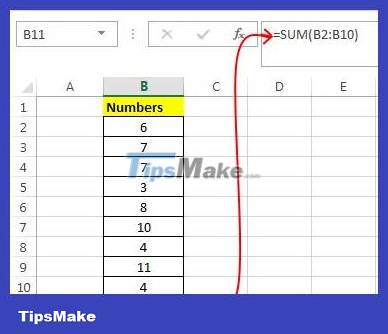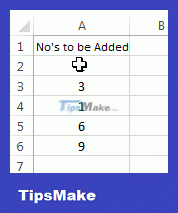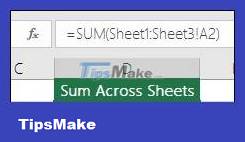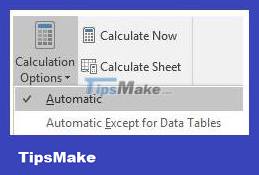SUM function in Excel: How to use SUM to calculate totals in Excel - SUM function in Excel
The SUM function in Excel is quite commonly used. Below are details on how to calculate the SUM function and related issues in Microsoft Excel.
If your job is office work and you often have to process a lot of data in Excel spreadsheets, you probably already know that this software has many useful functions. From simple functions like addition, subtraction, multiplication and division to complex functions like dates, calculating the smallest and largest numbers, etc. In this article, we will learn together the SUM function in Excel.
These are the main content in this article:
What is the SUM function in Excel?
Simply put, the SUM function adds values. It is designed to return a SUM function of user-supplied values, from individual values, ranges, cell references, or a combination of all three. The SUM function in Excel can handle up to 255 individual references well.
Formula of the SUM function in Excel
Understanding the formula of the SUM function in Excel can help you clearly understand how this function works. The total function formula in Excel is as follows:
The SUM function has two structures so can be written in two ways:
- =SUM(num1,num2, . num_n). Here " num1,num2, . num_n" represents the numbers we will calculate.
- =SUM(CellRange1,CellRange2,.CellRange_n). In which: "CellRange1,CellRange2,. CellRange_n" are numeric columns.
Notes in SUM calculation:
- The SUM function can calculate decimals and fractions.
- In the SUM calculation: =SUM(num1,num2, . num_n) , if you enter the parameter "num" as a non-number, the SUM function will display the #Name error? Error .
- And similarly, in the calculation =SUM(CellRange1,CellRange2, .CellRange_n) containing non-numeric content, the SUM function will ignore that value.
- The SUM function is not a dynamic function. Therefore, if you use the SUM calculation on a range of cells and then filter out certain values, the output of the SUM calculation will not change according to the closest value. Therefore, it is better to use the Subtotal function for this case.
Common SUM functions
The 'members' of the SUM function in Excel all have two things in common: one is that they sum all values in the same way, second is that they all have SUM in the name.
The first function, SUM just sums the input and output values of the result. The other SUM function performs the same task but with some changes. For example, SUMIF adds only values that meet specific conditions. SUMPRODUCT performs an arithmetic operation on the array, then sums the result.
Although all SUM functions calculate sums, that is not their only feature. Understanding how to use other SUM functions can increase your productivity. You do not need to combine SUM with other Excel functions, instead, just use the SUM function that suits your needs.
Some popular SUM functions today:
- SUM is the most basic member of Excel's sum function.
- SUMIF sums the range of numbers that meet a specific requirement.
- SUMIFS calculates sums based on multiple criteria.
- SUMPRODUCT multiplies a range of numbers, then sums them.
Examples of the SUM function

In the table above, there are four types of SUM function and below I will explain each specific example:
1. Example 1, sum of integers: =SUM(10,11,19) means adding the numbers 10,11,19 and 40 is the result 40.
2. Example 2, sum of decimal numbers: =SUM(10.2,9.6,2,4) , is simply the addition of 10.2+9.6+2.4 and gives the result 25.8.
3. Example 3, sum of fractional numbers: =SUM(4/2,8/2) . The calculation adds the numbers 4/2 and 8/2 and the result is 6.
4. Example 4, the SUM function fails because it contains non-numeric content and that is also the reason why the calculation produces #Name? Error .

5. Use the second form of the SUM function [=SUM(B2:B10)] to calculate the sum of the numbers in the number range (B2:B10) instead of the parameters and produce the result 60.
Shortening of the SUM calculation:
Instead of writing the calculation in a simple way, you can use the following:

First, select the number range then press " Alt + " and the results will be displayed in the next box.
Use other operations in the SUM calculation
Other calculations such as (+, - , / and *) can be used in the SUM function. For example, =SUM(2*4) and the SUM function will output 8. Similarly with the remaining calculations.
In fact, the SUM function will handle all sets of numbers including ranges or calculations. So first thing it will evaluate the result of patch operation if there is no difference then it will produce the result.
Use the SUM Function with other functions
1. It is completely possible to use the SUM function along with other functions. Here is an example calculating monthly average:

=SUM(A2:L2)/COUNTA(A2:L2)
2. SUM of A2:L2 divided by the number of months in the year in A2:L2 excluding blank cells.
Use the SUM function across multiple worksheets
1. Normally, to sum cells with the same location in pages, you will have to click on that cell on each page and use the "+" sign between the values, but this will take a lot of time and calculation. will error.
=Sheet1!A1+Sheet2!A1+Sheet3!A1
Therefore, this problem will become easier when using the SUM 3D function:

=SUM(Sheet1:Sheet3!A1)
The SUM function summed cells A1 contained in all sheets 1 through 3.
This method is useful for calculating single pages of months (January to December).

=SUM(January:December!A2) added all cells A2 on each page from January to December
This 3D method is similarly used in the functions AVERAGE, MIN, MAX,.
- =AVERAGE(Sheet1:Sheet3!A1)
- =MIN(Sheet1:Sheet3!A1)
- =MAX(Sheet1:Sheet3!A1)
Common problems and solutions:
Case 1: The SUM function displays #####.
Please check the column width, as ##### indicates there is not enough space to display the results.
Case 2: The SUM function displays text and does not produce results. Or only show numbers but not decimals.
Check the column format again. Go to Format and select Number to choose the format you want. If after formatting, the text displayed in the cell does not change, you should press F2 and enter.
Case 3: The SUM function does not update.
You must make sure that Calculation is set to Automatic mode . First go to Formula , select Calculation options . Then press F9 to automatically update the page.
Case 4: Some values are not used in the SUM function.
Only values or ranges that contain numbers can be placed in the function. Empty cells, logical functions, or text will be removed.
Case 5: The function produces the result #NAME? Error.
There is a spelling error here. For example, =sume(A1:A10) instead of =SUM(A1:A10).
Frequently asked questions when using the SUM function in Excel
How to show more/fewer decimal places? You can change the number format. Select the cell or range in question and use Ctrl + 1 to open the Format Cells dialog box, then click the Number tab and choose the format you want, making sure to specify the number of decimal places you want.
How to add or subtract time? You can add and subtract time in a number of different ways. For example, to calculate the difference between 8:00 a.m. and 12:00 noon for payroll purposes, you would use =("12:00 PM"-"8:00 AM")*24, subtracting the end time start time. Note, Excel calculates time as a fraction of a day, so you need to multiply by 24 to calculate total working hours. In the first example, use =((B2-A2)+(D2-C2))*24 to calculate the total number of hours from start to finish, minus the lunch break (8.5 hours total). .
How to get the difference between dates? Similar to time, you can add and subtract dates. This is an extremely common example of how to calculate the number of days between two different dates. The formula for using the SUM function in Excel here is very simple: =B2-A2. The 'key' to process the information here is to take the ending date/time and subtract the starting date/time.
How to sum the displayed cells? Sometimes when you manually hide rows or use AutoFillter to show only certain data, you also want to count only the visible cells. You can use the SUBTOTAL function. If you're using a total row in an Excel table, any function you choose from the Total drop-down menu will automatically be entered as the subtotal.
You should read it
- 3 ways to calculate totals in Excel
- How to use DSUM function in Excel
- How to automatically calculate and copy formulas in Excel
- Practical exercise on computer rental list in Excel
- DATEDIF () function (calculate the total number of years, total months or total days from two given periods) in Excel
- The easiest way to calculate the percentage (%)
- Calculate the subtotal of the list on Excel
- Practical exercises on Notebook price list in Excel
May be interested
- How to use the Power function in Excel
 the power function in excel is a power function with a given number that you don't need to calculate manually.
the power function in excel is a power function with a given number that you don't need to calculate manually. - How to calculate the number of days in Excel
 how many days from january 9, 2015 to june 12, 2017? if you can find results within 5 seconds, you are truly a genius. however, this is no longer a problem when you know how to use excel.
how many days from january 9, 2015 to june 12, 2017? if you can find results within 5 seconds, you are truly a genius. however, this is no longer a problem when you know how to use excel. - PMT function in Excel - Usage and examples
 the pmt function is one of the built-in financial functions of the excel software used to calculate the payment for a loan based on regular payments and a constant interest rate. the pmt function is not only useful for businesses, but also very practical for users if you want to calculate a loan.
the pmt function is one of the built-in financial functions of the excel software used to calculate the payment for a loan based on regular payments and a constant interest rate. the pmt function is not only useful for businesses, but also very practical for users if you want to calculate a loan. - How to calculate the total value based on multiple conditions in Excel
 to calculate conditional sum in excel, it is impossible not to mention the special calculation function that is sumif and sumifs function. software tips will guide how to use conditional sum function. please follow the following article.
to calculate conditional sum in excel, it is impossible not to mention the special calculation function that is sumif and sumifs function. software tips will guide how to use conditional sum function. please follow the following article. - ABS function (absolute value calculation) in Excel
 when you need to calculate absolute values for numbers in excel spreadsheets, you can use the abs function to calculate. the abs function helps you calculate the absolute value of a number, an expression or reference containing a number.
when you need to calculate absolute values for numbers in excel spreadsheets, you can use the abs function to calculate. the abs function helps you calculate the absolute value of a number, an expression or reference containing a number. - How to calculate the average in Excel
 the following article guides you in detail how to calculate the average in excel. there are 2 ways to calculate the average value: - calculate the average value according to the usual calculation formula. - calculate the average value using the average function.
the following article guides you in detail how to calculate the average in excel. there are 2 ways to calculate the average value: - calculate the average value according to the usual calculation formula. - calculate the average value using the average function. - Average function (calculate the average) in Excel
 the average function in excel helps you calculate the average value for a range of numbers, an array, or a reference containing numbers quickly and accurately.
the average function in excel helps you calculate the average value for a range of numbers, an array, or a reference containing numbers quickly and accurately. - SQRT function, how to use square root function in Excel
 the sqrt function in excel helps us quickly calculate the square root value of a number.
the sqrt function in excel helps us quickly calculate the square root value of a number. - How to use the AVERAGE function in Excel
 average function on excel will calculate the average of the data in the spreadsheet.
average function on excel will calculate the average of the data in the spreadsheet. - SUM function in Excel, sum function and examples
 sum is a basic excel function that allows users to quickly and accurately calculate the sum of columns or cells in an excel spreadsheet. for an overview of the concept, formula and how to use the sum function in excel, readers can refer to our article below. with many illustrative examples from simple to complex, readers can understand and quickly apply this function to practical work.
sum is a basic excel function that allows users to quickly and accurately calculate the sum of columns or cells in an excel spreadsheet. for an overview of the concept, formula and how to use the sum function in excel, readers can refer to our article below. with many illustrative examples from simple to complex, readers can understand and quickly apply this function to practical work.










 How to Make a Copy of a Page in a PDF Document
How to Make a Copy of a Page in a PDF Document How to Print Documents
How to Print Documents How to Send Files via Facebook
How to Send Files via Facebook How to Convert Word documents to JPEG image format
How to Convert Word documents to JPEG image format How to Delete Pages in PDF Files
How to Delete Pages in PDF Files How to Copy and Paste the Contents of a PDF File into a New File
How to Copy and Paste the Contents of a PDF File into a New File